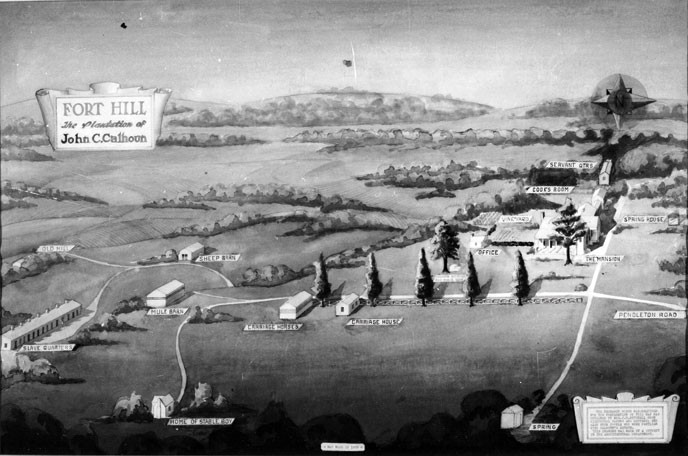Fort Hill Enslaved Quarters Historical Marker
Introduction
Text-to-speech Audio
Images

Sketch of the Fort Hill plantation area

Backstory and Context
Text-to-speech Audio
The Fort Hill Plantation sat on approximately 1,100 acres of land, most of which now encompasses the main parts of the university’s campus. The plantation primarily produced cotton to be sold in Charleston. Before 1850, the US Census only recorded the numbers of enslaved persons living on a given property. Beginning in 1850, ages, gender, and race were added, but names remained absent. Historians rely on these documents, and the wills and personal correspondence of the family, to piece together the identities and stories of enslaved persons. At Fort Hill, Census records, wills, estate records, letters, and diaries have provided information about the enslaved community, but readers must be cautious of the potential for bias in these documents since strict laws and codes prevented most African-Americans from leaving their own written accounts of their lives.
In the 1850 U.S. Census, the Calhoun family is recorded as owning seventy-five enslaved persons at Fort Hill and 116 enslaved personas in Marengo County. A small portion of the population at Fort Hill would have been assigned as domestic laborers, working in and around the home attending to the daily needs of the family. The rest of the enslaved living at Fort Hill would have been field laborers, working in the heat and sun everyday to plant, tend, and harvest the cotton crop with which the Calhoun family sustained their wealth. The two sets of laborers had separate quarters depending on their assignment; the domestic enslaved were housed closer to the home, while the field laborers’ quarters were closer to the fields. According to Joseph Scoville, a reporter for the New York Herald writing in 1849, the field laborers were housed in quarters “built of stone and joined together like barracks, with gardens attached, and a large open space in front.” In 1860, there were only fourteen enslaved quarters on the property for a sizable population.
In 1865, after the death of John C. Calhoun’s eldest son, A.P. Calhoun, an appraisal of his estate was performed which detailed the worth of all of his property, including his enslaved property. Through this document, historians have learned the names of the 139 enslaved persons living at Fort Hill at this time. They were:
Sawney, age 71; Tiller, age 62; David, age 2; Matilda, age 23; Bella, age 3; Mary Jane, age 1; Jim, age 20; Pheoby, age 25; Laura, age 2; Emaline, age 3 months; Susan, age 22; Binah, age 19; Babe, age 6 months; Armstead, age 14; James, age 11; Fiddy, age 4; Thomas, age 1; Jimmy, age 23; Delphy, age 20; Janice, age 3; Harriet, age 23; Francie, age 17; Christy, age 2; Richard, age 13; Isaac, age 11; Margaret, age 21; Aaron, age 4; Edward, age 32; Fanny, age 7; Allen, age 6; William, age 4; Robert, age 2; Nancy, age 18; Jervis, age 6 months; Peter, age 22; Dick, age 18; Babe, age 6 months; Richard, age 10; Amos, age 35; Sarah Ann, age 35; Binah, age 17; Tom, age 16; Cato, age 14; Moses, age 9; Rose, 5; Izzy, age 4; Peggy, age 88; Isaac, age 33; Edward, age 16; Alick, age 12; Katy, age 64; Cloe, 58; Orr, age 33; Wash, age 39; Hammer, age 37; Daphney, age 18; Sam, age 30; Lucy, age 19; Allison, age 15; Jack, age 12; Jonas, age 29; Chapman, age 25; Harry, age 41; Delia, age 41; Harry, age 23; Margaret, age 20; Sarah Ann, age 12; Eliza Ann, age 14; Jack, age 16; Billy, age 45; Jane, age 38; Amos, age 17; Sue, age 15; Peggy, age 13; Kate, age 11; Alick, age 7; Mary, age 9; Beller, age 64; Sharper, age 33; Richmond, age 33; Caroline, age 30; Solomon, age 11; Tiller, age 8; Simon, age 6; George, age 32; Martha, age 32; Hammer, age 16; John, age 51; Binah, age 48; Jack, age 9; Frank, age 26; Amy, age 24; David, age 9; Alick, age 7; Betty, age 6; Ben, age 26; Becky, age 22; Lizzie, age 3; Dink, age 26; Susan, age 25; Beck, age 4; Mack, age 23; Ellen, age 22; Amos, age 16; Pheobus, age 34; Kitty, age 34; Robert, age 18; William, age 11; Stephaney, age 8; Mary, age 5; Martha, age 6 months; Jasmin, age 51; Massey, age 42; Jim, age 26; Darcas, age 34; Katy, age 15; Abb, age 32; Joe, age 8; Arthur, age 3; Tom, age 32; Jane, age 28; Moses, age 12; Tom, age 4; Peter, age 50; Ephraim, age 29; Maria, age 20; Nancy, age 3;
Stepny, house servant; Alick, house servant; Jane, house servant; Louisa, Billy’s wife, house servant; Ella, age 11, house servant; Louisa, Edward’s wife, house servant; Christy, cook; Isaac, gardener; Pries, coachman; Billy, miller; Nicholas, Blacksmith; and Ted, carpenter.
Sources
Newsstand | Clemson University News and Stories, South Carolina. “Markers Signal New Effort to Tell Clemson’s Full History.” Accessed May 26, 2020. https://newsstand.clemson.edu/mediarelations/markers-signal-new-effort-to-tell-clemsons-full-history/.
https://newsstand.clemson.edu/mediarelations/markers-signal-new-effort-to-tell-clemsons-full-history/
image courtesy of Fort Hill
